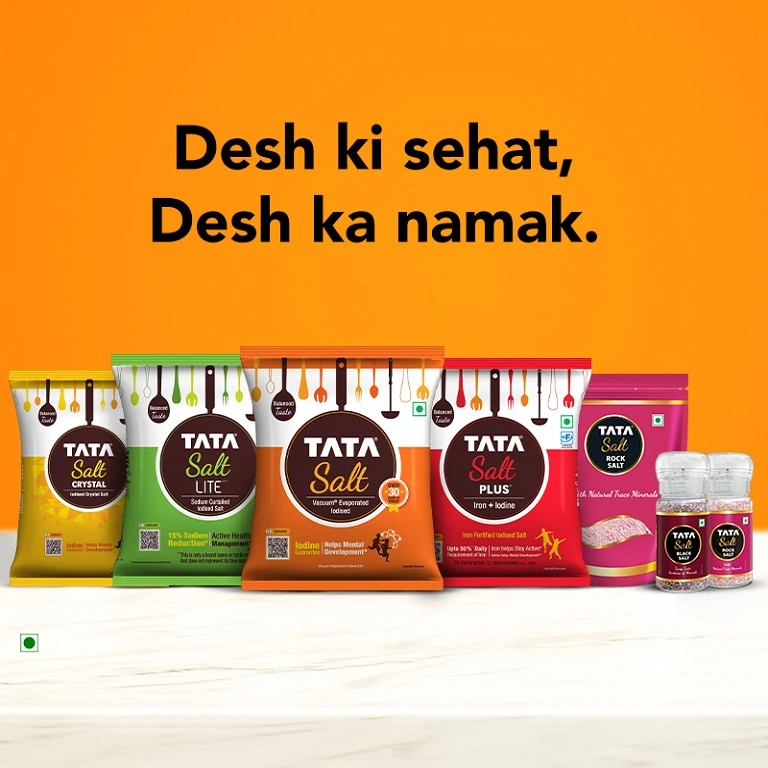Tata Salt isn’t just a brand; it’s a name that resonates with almost every Indian household. Over decades, it has become synonymous with purity, health, and trust. Back in 1983, Tata Salt was introduced by Tata Chemicals with a simple yet powerful vision: to provide every Indian household with pure, high-quality iodized salt.
At the time, the salt industry in India was fragmented, and unbranded, impure salt dominated the market. This also led to iodine deficiency – a serious public health issue causing conditions like goiter and cognitive impairments.
Tata Salt entered the market as India’s first branded iodized salt, tackling not only a nutritional need but also setting a new standard for quality and hygiene.
Key milestones from the founding days include:
- Addressing Public Health Needs:
Tata Salt was launched as part of India’s broader mission to eradicate iodine deficiency.
- Technology Leadership:
Vacuum evaporation technology ensured salt that was clean, consistent, and enriched with iodine.
The Tata Group’s strong reputation for trustworthiness played a pivotal role in making Tata Salt an instant hit. The brand positioned itself as a product that ensured the well-being of families, reinforcing the idea that something as simple as salt could have a profound impact on life.
Tata Salt’s tagline, “Desh ka Namak” (The Nation’s Salt), beautifully encapsulated this vision, making it much more than just a seasoning – it became a reflection of India’s progress and a source of national pride.
Branding of Tata Namak
Tata Namak’s branding is a masterclass in consistent messaging, emotional resonance, and long-term trust-building.
The Power of Consistent Positioning:
From its inception, Tata Namak’s slogan, “Desh ka Namak”, has been more than a tagline – it’s a promise. This simple yet powerful phrase aligns the brand with national pride and emotional belonging, making it resonate deeply with Indian consumers. Tata Namak leverages Tata Group’s credibility. Consumers associate the brand with uncompromising quality and purity.
Building a Legacy Through Branding:
Unlike brands that frequently shift messaging to chase trends, Tata Namak has stayed steadfast. The core message of purity, trust, and patriotism has endured, allowing the brand to build equity and become deeply embedded in consumers’ minds.
Families often pass down purchasing habits, and Tata Namak’s reputation ensures loyalty across generations. Grandparents and parents trust it, leading to automatic adoption by younger family members.
The Impact of Legacy Branding:
The ability to maintain a single, strong positioning has allowed Tata Namak to dominate the Indian salt market, claiming a 41% market share in the branded salt space.
Tata Namak’s advertising consistently reinforces its positioning. Campaigns featuring messages about trust, health, and the nation’s progress emphasize its role in the larger narrative of Indian society.
Why Legacy Branding Works:
- Loyalty Beyond Logic:
When a brand becomes a legacy, it transcends price wars and market fluctuations. Consumers stick to Tata Namak not because of discounts but because of emotional attachment and trust built over decades.
- Reduced Marketing Costs Over Time:
A consistent position eliminates the need for frequent rebranding, saving costs while reinforcing brand recall.
- Association with Larger Values:
Legacy brands are often perceived as embodying larger societal values. Tata Namak’s branding ties it to its core values, creating a halo effect that differentiates it from competitors.
- Adaptability While Staying True:
Even as Tata Namak evolves (e.g., introducing rock salt and black salt for health-conscious consumers), it retains the core identity of purity and trust.
Tata Salt understood that branding isn’t just about what you sell but about what you stand for. It shows that even in a commodity market, emotional connections can drive loyalty.
Marketing Mix
Product:
Tata Salt is more than just a brand – it’s a category leader that consistently adapts to changing consumer demands. Tata Salt’s flagship product tackles one of India’s significant public health challenges – iodine deficiency. By offering a high-quality iodized salt, Tata positioned itself as a brand synonymous with purity and health.
To cater to evolving consumer preferences, Tata Salt expanded its portfolio with innovative products:
- Tata Lite:A low-sodium salt aimed at health-conscious individuals, especially those managing hypertension or cardiovascular health. It is positioned as a premium product in urban markets.
- Tata Rock Salt:A natural, unrefined salt popular for gourmet cooking and wellness enthusiasts. It emphasizes purity and mineral content, appealing to upscale consumers.
- Tata Black Salt:A staple in Indian kitchens, known for its digestive benefits. It connects with traditional cooking habits and cultural roots.
With this, Tata Salt caters to both mass-market consumers and niche audiences, ensuring inclusivity and relevance.
Price:
Tata Salt ensures its prices remain affordable for middle-class households, competing directly with regional and unbranded salts. This approach helps Tata Salt maintain its status as an essential product for every Indian home.
Products like Tata Rock Salt and Tata Lite are priced higher, targeting urban and health-conscious consumers willing to pay a premium for better health and unique features. This dual pricing strategy allows the brand to capture value across both price-sensitive and upscale markets.
Place:
Tata Salt’s robust distribution network ensures it’s available wherever the consumer is. Tata Salt is stocked in kirana stores across rural and urban India.
Products are prominently displayed in supermarkets and hypermarkets like Big Bazaar and Reliance Fresh. This visibility caters to urban shoppers who prefer the convenience of modern trade. Tata Salt’s specialty products like Tata Lite and Tata Rock Salt are available on platforms like Amazon and Flipkart, appealing to urban consumers who shop online.
Promotion:
Over the decades, Tata Salt has used both traditional and digital channels for marketing. before their patriotic positioning, they leveraged the trust people had in the Tata Group in their advertisements with this campaign:
In 2002, they launched the “Desh ka Namak” campaign and have nailed this positioning to be relatable pan India.
In 2024, they also revived the above jingle, merging it with IPL in 2024:
In fact, before launching this campaign, their pre-launch strategy involved literally trying to get people to jog their memories for the jingle like this.

Their approach is also educational, with creative campaigns like this

Apart from that, the brand is also active on social media with 43.8K followers on Instagram. They collaborate with influencers to stay on top-of-mind:

They also engage the audience through this campaign:

This helps real people to be involved and be a part of a larger people.
In a Nutshell
By entering the market with India’s first branded iodized salt, Tata Salt not only solved a critical health issue but also set a new benchmark for quality in a fragmented industry. Over the years, the brand has been able to maintain a balance between legacy and innovation, enabling it to be a leading player in the branded salt industry.
Key Takeaways from Tata Salt’s Marketing
- Solve Real Problems:
Addressing public health issues like iodine deficiency positioned Tata Salt as essential and trusted.
- Leverage Legacy:
Align your brand with values like trust and national pride to build emotional connections.
- Innovate for Niche Audiences:
Cater to diverse needs with products like low-sodium and black salt to expand market reach.
- Consistency is Key:
A strong tagline like “Desh ka Namak” reinforces brand identity and aids recall.
- Use Strategic Pricing:
Dual pricing strategies allow capturing both price-sensitive and premium markets.


